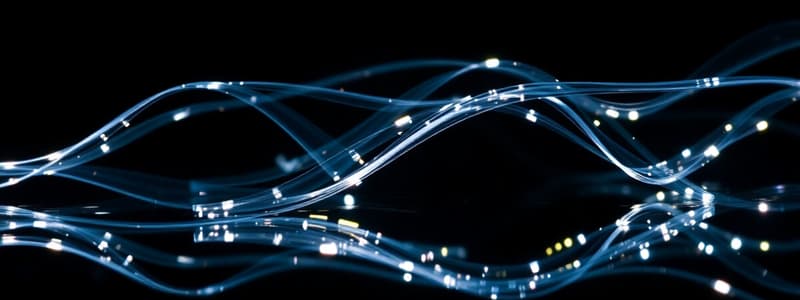Podcast
Questions and Answers
What makes objects visible in a room?
What makes objects visible in a room?
Light reflects off objects and reaches our eyes.
Light travels in straight lines.
Light travels in straight lines.
True (A)
What is the phenomenon called when light bends around a small opaque object?
What is the phenomenon called when light bends around a small opaque object?
- Reflection
- Diffraction (correct)
- Refraction
- Dispersion
What are the laws of reflection of light?
What are the laws of reflection of light?
What is the nature of the image formed by a plane mirror?
What is the nature of the image formed by a plane mirror?
Light is thought of as a wave to explain phenomena such as ______.
Light is thought of as a wave to explain phenomena such as ______.
Flashcards are hidden until you start studying
Study Notes
Light: Reflection and Refraction
- Light enables us to see objects; objects reflect light, which is received by our eyes.
- We see through transparent mediums because light is transmitted through them.
- Light generally travels in straight lines; this is demonstrated by the sharp shadows cast by opaque objects.
- Diffraction of light is a phenomenon where light bends around very small objects, deviating from a straight path. This is not explained by ray optics alone.
- The wave theory of light is sometimes inadequate for describing interaction with matter; light also exhibits particle behavior. Quantum theory reconciles wave and particle properties.
- This chapter focuses on reflection and refraction of light using the straight-line propagation model.
Reflection of Light
- Polished surfaces, like mirrors, reflect most incident light.
- Laws of reflection:
- Angle of incidence equals angle of reflection.
- Incident ray, normal at the point of incidence, and reflected ray lie in the same plane.
- These laws apply to all reflecting surfaces, including spherical surfaces.
- Plane mirror image characteristics:
- Virtual and erect.
- Same size as the object.
- As far behind the mirror as the object is in front.
- Laterally inverted.
- Curved mirrors (like a spoon's surface) produce images with varying characteristics depending on the curvature and object position. The image size and characteristics change as the object's distance to the mirror changes.
Studying That Suits You
Use AI to generate personalized quizzes and flashcards to suit your learning preferences.




